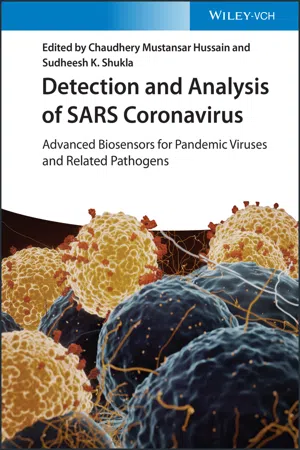
Detection and Analysis of SARS Coronavirus
Advanced Biosensors for Pandemic Viruses and Related Pathogens
- English
- ePUB (mobile friendly)
- Available on iOS & Android
Detection and Analysis of SARS Coronavirus
Advanced Biosensors for Pandemic Viruses and Related Pathogens
About This Book
Detection and Analysis of SARS Coronavirus
Detecting and analyzing the COVID-19 pandemic with biosensor technology
The highly contagious SARS CoV-2 pathogen has challenged health systems around the world as they struggle to detect and monitor the spread of the pathogen. In Detection and Analysis of SARS Coronavirus: Advanced Biosensors for Pandemic Viruses and Related Pathogens expert chemists Chaudhery Mustansar Hussain and Sudheesh K. Shukla deliver a practical analysis of how contactless coronavirus detectors may be developed using existing biosensor technology.
The editors outline current challenges in the field, the bioanalytical principles for coronavirus detection, and available biosensor technology. They then move on to how available technology might be adapted to detect coronaviruses and how commercialization of the technology might unfold.
The lessons learned in this book are readily applicable to the study of other current and emerging pathogens.
Readers will also enjoy:
- A thorough introduction to the current diagnostic approaches for COVID-19, including common challenges, technology adaptation, and future potential
- An exploration of bio-analytical strategies for SARS CoV-2/COVID-19, including COVID detection via nanotechnology, biosensing approaches, and the role of nanotechnology in coronavirus detection
- Practical discussions of biosensors for the analysis of SARS CoV-2/COVID-19, including sensor development for coronavirus and chemical sensors for coronavirus diagnosis
- In-depth treatments of the commercialization and standardization for analytical technologies
Perfect for virologists, pharmaceutical industry professionals, and sensor developers, Detection and Analysis of SARS Coronavirus is also an indispensable resource for those working in analytical research institutes, biotechnology industry professionals, and public health agency professionals.
Frequently asked questions
Information
Part I
Introduction
1
Current Diagnostic Approach for COVID‐19
1.1 Introduction
1.2 Recommended Laboratory Diagnosis for COVID‐19
1.2.1 SARS‐CoV‐2 Testing: Detection Approach by Screening Suitable Specimen Cultures
1.2.2 SARS‐CoV‐2 Detection: The Nucleic Acid Approach
1.2.2.1 COVID‐19 Detection Approach Through Real‐Time PCR
Table of contents
- Cover
- Table of Contents
- Title Page
- Copyright
- Dedication
- Preface
- About the Editors
- Part I: Introduction
- Part II: Bio‐analytical Strategies for SARS‐CoV‐2/COVID‐19
- Part III: Biosensors for Analysis of SARS‐CoV‐2/COVID‐19
- Part IV: Commercialization and Standardization of Analytical Technologies
- Part V: Outlook
- Index
- End User License Agreement